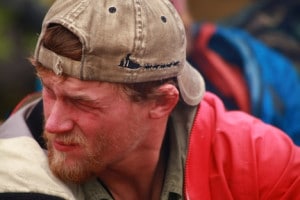- Our On-Site Arnold Classic Coverage
- XFL AND USFL ANNOUNCE INTENT TO MERGE
- Apparel, Subscriptions, Back & Single Issues
- Ammannomics Our 2023 Olympia Title Sponsor
- Gregg Valentino – Blocking All Estrogen is Bad / Best Liver Care Advice / Right Amount of Protein
- Springballers Daily USFL Updates
- Magzter Digital Version of MuscleSport Magazine
- mSm APP – Free Download
- Earning a Living in the Bodybuilding / Fitness Industry
- Three Instagram Live Shows Per Week
Dallas Seavey From NatGeo TV’s “Ultimate Survival Alaska”
- Updated: December 27, 2014
1 – How do you prepare for the cold temperatures and not allow that to inhibit you in any way? (This is geared more towards a fitness standpoint rather than clothing, layers, shelter, etc.)
A person’s body does acclimate to colder temperature and exposure over time, so I have a bit of an advantage having raced sled dogs in Alaska for the last 20 years. As it pertains to the Iditarod and Ultimate Survival Alaska, knowing the limitations of my body is very valuable. Being aware of the calories I do or don’t have to burn is essential. I have to make sure I have a enough fuel when I’m on the verge of hypothermia or I could be in a critical situation. I need to be aware of how much more heat can I produce. Knowing that threshold allows me to know what to do next. Knowing my body helps me understand the next action I need to take right then and there to stay out of trouble.
2 – The Iditarod is a challenge in many ways and the endurance factor is one that surely comes into play. To do this event for 8 or 9 days straight must be a daunting task, indeed. Just what do you do to keep moving?
I love tough situations. I race the Iditarod because I know that by the end it, it will truly push me to the limit. I thrive on doing things that push me to that edge where I learn something new about my body and I don’t really know what’s going to happen next until I truly do hit the wall.
3 – Perhaps a question a bit off topic, but an interesting one, nonetheless. Just how do you keep your team of dogs healthy and able to do this event with you?
Good question. This IS the event! The Iditarod is about maintaining a healthy dog team and realizing that you’re not the best athlete in this competition – the dogs are the true athletes. Our job is to prepare the right food, give the dogs massages, and stay awake while the dogs are taking turns sleeping. They’ll sleep 8-10 hours a day on the race while we keep mushing. It’s always more valuable to take care of the dog team’s needs first and then physically help out the team (for example, helping the dogs with the sled pulling) if I have the energy left. But taking care of the dogs is the top priority.
4 – How often do you stop for rest, meals and bathroom breaks for you and your team?
The schedule depends on the trail and weather conditions. Typically we travel between 50-70 miles at a time, taking a 4-6 hour rest and then starting again. During a run, we’ll stop for a bathroom or snack break about every hour during that session, but then it’s back to running.
5 – Do you need to follow a special diet before an event to get your body ready and during one?
My diet before the Iditarod is simple: eat as much of whatever I can as possible. Weight is not a huge concern but having enough energy on the race will be. During the Iditarod, I want as much body fat as possible (granted, I don’t have much). During the race we rely on the reserves we have and rely on snacks as we can take them.
Last year, I started the race at 150 lbs (I’m usually closer to 160 at the start) and I was concerned. I finished the race at 138 lbs. So you’re starting out scrawny and your body is going to burn any fuel so you have to eat out there…even when you’re sleep deprived. Your body can’t produce heat without calories, so you have to take on fuel whenever you can. If I had to tell a new musher what to take with them, it would be something they WANT to eat not something necessarily heathy to eat.
Your body will burn everything, but you have to WANT to eat it. So I would take a candy bar before I would take quinoa. An example of a food I eat on the trail: egg roll-sized burritos (beef, chicken) that I can cook in melted snow and that thaw quickly. They’re a small size and easy to eat. When you’re dehydrated and your lips are chapped and cracked from windburn, something small in size is always good.
6 – It is amazing that you are a third-generation dog sled racer and you will be facing your dad coming up. What does that mean to you and him and do you have any children that may follow in your footsteps?
My family has an extremely long history in dog mushing and my dad and I both take pride in that. Yes, we’ll both be racing the 2015 Iditarod as the two most recent champions from the last two seasons. We’re best friends, but I’ll compete against him like every other competitor. I want to beat everybody – but if that’s not going to happen, I want him to win. Ideally, we’ll come in first and second place.
Season Three of Ultimate Survival Alaska premieres Sunday, January 4 at 9:00pm ET on National Geographic Channel.
Photos courtesy of Bullseye Communications































Pingback: Niall McCann - Nat Geo Wild's "Biggest & Baddest" | Muscle Sport Magazine